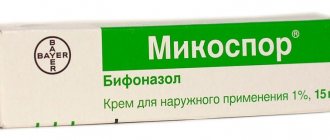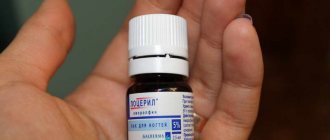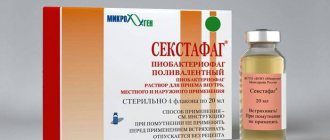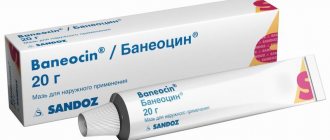Compound
active ingredient:
1 bottle contains sterile chloramphenicol sodium succinate in terms of chloramphenicol 0.5 g or 1.0 g.
Dosage form.
Powder for solution for injection.
Basic physical and chemical properties:
white or white powder with a yellowish tint. Hygroscopic.
Pharmacotherapeutic group.
Antimicrobial agents for systemic use. Amphenicols.
ATX code J01B A01.
Pharmacological properties
Pharmacodynamics.
Broad-spectrum antibiotic. Effective against many gram-positive (staphylococci, streptococci, pneumococci, enterococci) and gram-negative bacteria: Escherichia coli and Haemophilus influenzae, Salmonella, Shigella, Klebsiella, Serracia, Yersinia, Proteus, gonococci, meningococci, anaerobes, rickettsia, spirochetes, chlamydia, some large viruses (pathogens of trachoma, psittacosis, inguinal lymphogranulomatosis and others); acts on bacterial strains resistant to penicillin, streptomycin, sulfonamides; weakly active against acid-fast bacteria, Pseudomonas aeruginosa, clostridia and protozoa. In normal doses it acts bacteriostatically. Inhibits peptidyl transferase and disrupts protein synthesis in the bacterial cell.
Pharmacokinetics.
With intramuscular and intravenous administration, a high concentration of the drug in the blood plasma is quickly achieved (5-10 minutes after intravenous, 30-45 minutes after intramuscular administration). The maximum concentration in the blood is reached after 1 hour and remains in effective concentrations in the blood plasma for 8-12 hours. A significant portion (60-80%) binds to plasma albumin. Easily penetrates into organs and body fluids, through the blood-brain barrier, through the placenta, and into breast milk.
It is excreted mainly by the kidneys in the form of inactive metabolites, partially with bile.
Clinical characteristics.
Levomycetin for injection
Pharmacological properties
Pharmacodynamics
Broad-spectrum antibiotic. Effective against many gram-positive (staphylococci, streptococci, pneumococci, enterococci) and gram-negative bacteria: Escherichia coli and Haemophilus influenzae, Salmonella, Shigella, Klebsiella, Seracia, Yersinia, Proteus, gonococci, meningococci, anaerobes, rickettsia, spirochetes, chlamydia, some large viruses ( pathogens of trachoma, psittacosis, inguinal lymphogranulomatosis, etc.); acts on bacterial strains resistant to penicillin, streptomycin, sulfonamides; weakly active against acid-fast bacteria, Pseudomonas aeruginosa, clostridia and protozoa.
In normal doses it acts bacteriostatically. Inhibits peptidyl transferase and disrupts protein synthesis in the bacterial cell.
Drug resistance to the drug develops relatively slowly, and, as a rule, cross-resistance to other chemotherapeutic agents does not occur.
Pharmacokinetics
With intramuscular and intravenous administration, a high concentration of the drug in the blood plasma is quickly achieved (5–10 minutes after intravenous administration, 30–45 minutes after intramuscular administration). The maximum concentration in the blood is reached after 1 hour and is maintained in an effective concentration in the blood plasma for 8–12 hours. A significant part (60–80%) binds to blood plasma albumin. Easily penetrates into organs and body fluids, through the blood-brain barrier, placenta, and into breast milk.
It is excreted mainly by the kidneys in the form of inactive metabolites, partly with bile.
Indications
Used for typhoid fever and paratyphoid fever, generalized forms of salmonellosis, dysentery, brucellosis, tularemia, meningitis, typhus and other rickettsioses, trachoma. For infectious processes, the pathogens of which are sensitive to the action of Levomycetin, in case of ineffectiveness of other chemotherapeutic drugs or if their use is impossible.
Application
For children, Levomycetin is recommended to be administered intramuscularly: for children under 1 year of age - 25-30 mg/kg body weight, over 1 year - 50 mg/kg in 2 doses with an interval of 12 hours. For adults Levomycetin is administered intramuscularly or intravenously . Solutions of the drug are prepared ex tempore
.
For intramuscular administration, the contents of the vial (0.5 g or 1.0 g) are dissolved in 2–3 ml of sterile water for injection and injected deep into the muscle. As a solvent for intramuscular administration, you can use 0.25% or 0.5% procaine solution.
For intravenous jet administration, a single dose of the drug is dissolved in 10 ml of sterile water for injection or in 5% or 40% glucose solution and administered slowly over 3–5 minutes. For patients with diabetes mellitus, the drug is administered in an isotonic solution of sodium chloride.
The daily dose of the drug for adults for general infections is 1–3 g; administer 0.5–1.0 g 2–3 times a day with an interval of 8–12 hours; if necessary, the daily dose is increased to 4 g.
In ophthalmology, the drug is used for parabulbar injections and instillations. When injecting, 0.2–0.3 ml of 20% solution is administered 1–2 times a day; for instillation, 5% solution (1-2 drops) is instilled into the conjunctival sac 3-5 times a day, prepared with water for injection or isotonic sodium chloride solution.
Aqueous 5% solution for instillation is stored for no more than 2 days.
Duration of use: 5–15 days.
Contraindications
In case of suppression of hematopoiesis, individual intolerance to the drug, skin diseases (psoriasis, eczema, fungal infections), deficiency of glucose-6-phosphate dehydrogenase, during pregnancy and lactation, in newborns.
Levomycetin should not be prescribed for acute respiratory diseases, sore throat and for the prevention of these diseases.
Side effects
Dermatitis, allergic reactions (skin rashes, urticaria, angioedema) may occur; dyspeptic symptoms; toxic effect on the hematopoietic system: leukopenia, thrombocytopenia, reticulocytopenia, decreased hemoglobin content; inhibition of intestinal microflora, development of dysbiosis, secondary fungal infection.
When using Levomycetin in the form of eye drops, local allergic reactions are possible.
Young children are most sensitive to the drug. In children under 1 year of age, cardiovascular collapse (gray syndrome) is rarely possible.
special instructions
Treatment with Levomycetin should be carried out under the control of the blood picture and the functional state of the patient’s liver and kidneys. Uncontrolled prescription of Levomycetin and its use in mild forms of infectious processes, especially in pediatric practice, should not be allowed.
Interactions
Levomycetin is not prescribed in combination with drugs that inhibit hematopoiesis (sulfonamides, pyrazolone derivatives, cytostatics).
As an inhibitor of liver cytochrome P450, Levomycetin can slow down metabolism and elimination, increase the blood level of diphenin, neodicoumarin, butamide, and barbiturates.
Cycloserine increases the neurotoxicity, ristomycin increases the hematotoxicity of Levomycetin. Phenobarbital accelerates the biotransformation of the drug, reduces its concentration and duration of effect. Levomycetin suppresses the metabolism of tolbutamide, chlorpropamide, and oxycoumarin derivatives (increases hypoglycemic and anticoagulant properties). Erythromycin, oleandomycin, nystatin, levorin increase antibacterial activity, benzylpenicillin salts decrease it. Incompatible with alcohol.
Overdose
Levomycetin in high doses can cause psychomotor impairment, confusion, visual and auditory hallucinations, and decreased hearing and vision acuity. The use of Levomycetin in high doses is also associated with severe complications from the hematopoietic system: agranulocytosis, aplastic anemia. In case of overdose, the drug must be discontinued.
Treatment is symptomatic.
Storage conditions
In a dry place, protected from light, at a temperature of 15–25 °C.
Contraindications
Hypersensitivity to chloramphenicol, other amphenicols, inhibition of hematopoiesis, blood diseases; skin diseases (psoriasis, eczema, fungal infections); severe dysfunction of the liver and/or kidneys; deficiency of the enzyme glucose-6-phosphate dehydrogenase; porphyria.
Levomycetin should not be prescribed for acute respiratory diseases, sore throat, or for the prevention of bacterial infection.
Interaction with other drugs and other types of interactions.
Long-term use of chloramphenicol, which is an inhibitor of liver enzymes, in the preoperative period or during surgery may reduce plasma clearance and increase the duration of action of alfetanil.
Chloramphenicol inhibits the cytochrome P450 enzyme system,
therefore, when used simultaneously with antiepileptic drugs (phenobarbital, phenytoin), indirect anticoagulants (dicoumarin, warfarin), there is a weakening of the metabolism of these drugs, a slower elimination, an increase in their concentration in the blood plasma and an increase in their toxicity.
With simultaneous use of Levomycetin with tolbutamide (butamide) and chlorpropamide
their hypoglycemic effect may increase (due to inhibition of metabolism in the liver and an increase in their concentration), which requires dose adjustment.
Phenobarbital, rifampicin, rifabutin
reduce the concentration of chloramphenicol in the blood plasma by accelerating its metabolism in the liver.
When used simultaneously with paracetamol
Prolongation of the half-life of chloramphenicol may occur.
Phenytoin
. With simultaneous use, both a decrease and an increase in the concentration of chloramphenicol in the blood plasma may be observed.
Cyclosporine
. When used simultaneously with chloramphenicol, an increase in the level of cyclosporine in the blood plasma may be observed; it is necessary to monitor the concentration of cyclosporine.
Cyclophosphamide
. Concomitant use extends the half-life of cyclophosphamide from 7.5 to 11.5 hours.
Tacrolimus
. When used simultaneously with chloramphenicol, an increase in the level of tacrolimus in the blood plasma may be observed. When used concomitantly, the dose of tacrolimus must be adjusted.
Levomycetin reduces the antibacterial effect of penicillins
and
cephalosporins
.
Macrolides (erythromycin, oleandomycin, clindamycin), lincosamides (lincomycin), polyene antibiotics (nystatin, levorin)
. With the simultaneous use of chloramphenicol with these drugs, a mutual weakening of the antimicrobial effect is observed due to the fact that chloramphenicol can displace these drugs from the bound state or prevent their binding to the 50S subunit of bacterial ribosomes. Therefore, their simultaneous use should be avoided.
Cycloserine
. Concomitant use increases the neurotoxicity of chloramphenicol.
Medicines that inhibit hematopoiesis (sulfonamides, cytostatics, cimetidine, ristomycin) or radiation therapy
when used simultaneously with chloramphenicol, they can enhance their inhibitory effect on the bone marrow and the severity of its manifestations.
When used simultaneously with vitamin B12
,
iron preparations, folic acid,
chloramphenicol can counteract the stimulation of hematopoiesis by vitamin B12, reducing the effectiveness of these drugs.
Long-term simultaneous use of chloramphenicol and estrogen-containing oral contraceptives
may lead to a decrease in the reliability of contraception and an increase in the frequency of breakthrough bleeding.
Ethanol
. When taking ethanol simultaneously, a disulfiram-like reaction may develop (skin hyperemia, tachycardia, nausea, vomiting, reflex cough, convulsions).
Interactions of the drug Levomycetin for injection
Levomycetin is not prescribed in combination with drugs that inhibit hematopoiesis (sulfonamides, pyrazolone derivatives, cytostatics). As an inhibitor of liver cytochrome P450, Levomycetin can slow down metabolism and elimination, increase the blood level of diphenin, neodicoumarin, butamide, and barbiturates. Cycloserine increases the neurotoxicity, ristomycin increases the hematotoxicity of Levomycetin. Phenobarbital accelerates the biotransformation of the drug, reduces its concentration and duration of effect. Levomycetin suppresses the metabolism of tolbutamide, chlorpropamide, and oxycoumarin derivatives (increases hypoglycemic and anticoagulant properties). Erythromycin, oleandomycin, nystatin, levorin increase antibacterial activity, benzylpenicillin salts decrease it. Incompatible with alcohol.
Application Features
The drug should only be used under medical supervision.
Considering the possibility of developing severe damage to the hematopoietic organs as a result of the toxic effect of the drug, during treatment the composition of the peripheral blood should be monitored, as well as the condition of the liver and kidneys.
If leukopenia, thrombocytopenia, anemia or other pathological changes in the blood occur, chloramphenicol should be discontinued immediately. Although constant monitoring of peripheral blood composition during treatment with chloramphenicol may detect early changes in the blood system (leukopenia, reticulocytopenia or granulocytopenia) before they become irreversible, this does not exclude the possibility of aplastic anemia through the development of bone marrow depression. Aplastic anemia, thrombocytopenia and granulocytopenia usually appear after the end of treatment. Therefore, symptoms such as pale skin, sore throat and fever, bleeding, weakness (if they appear several weeks or months after discontinuation of the drug) require emergency care. Long-term use of chloramphenicol may lead to an increased tendency to bleeding, which may be due to both suppression of bone marrow function and suppression of normal intestinal microflora, which leads to inhibition of vitamin K synthesis.
In patients with impaired liver or kidney function, serum levels of chloramphenicol may be increased and the risk of developing toxic reactions to this drug may be higher, so the dosage should be adjusted accordingly. It is advisable to periodically determine the concentration of the drug in the blood by checking liver and kidney function.
Clinical experience with the use of chloramphenicol did not reveal differences in the effectiveness of therapy in patients of different age categories. However, taking into account age-related characteristics of the function of the kidneys, liver, cardiovascular system, the presence of concomitant diseases, and the use of other medications, it is necessary to carefully determine the dose of the drug for elderly patients, starting, as a rule, from the lower limit of the dosage range. Treatment with antibacterial drugs leads to disruption of the normal flora of the large intestine and can cause excessive growth of Clostridium difficile, the toxins of which are the main cause of pseudomembranous colitis. Pseudomembranous colitis can occur both directly while taking the drug and within 2 months after the end of antibacterial therapy. Cases of pseudomembranous colitis ranging from mild to life-threatening conditions have been reported with the use of almost all antibacterial drugs, including chloramphenicol. Therefore, it is important to clarify the diagnosis in patients with diarrhea after taking antibacterial drugs.
In the absence of necessary treatment, toxic megacolon, peritonitis, and shock may develop. It must be taken into account that the development of colitis is most likely in severe illnesses in elderly people, as well as in weakened patients.
The use of antibacterial drugs can lead to excessive growth of insensitive microorganisms, in particular fungi. If infections caused by insensitive microorganisms develop during treatment, appropriate measures must be taken.
When using the drug, it is necessary to monitor the blood picture. Data regarding any harmful effects on blood elements are an indication for immediate discontinuation of drug therapy.
In patients previously treated with cytotoxic drugs or who have used radiation therapy, the potential risks and expected benefits of treatment with chloramphenicol should be assessed, taking into account the possibility of developing severe side effects.
Chloramphenicol should not be used to treat or prevent mild infections, or for any infection for which less toxic antibiotics are available. Repeated courses and prolongation of treatment should also be avoided.
Use with caution in case of cardiovascular diseases and a tendency to allergic reactions.
The use of chloramphenicol has been associated with acute attacks of porphyria, and the use of chloramphenicol in patients with porphyria is considered unsafe.
Each gram of sodium chloramphenicol succinate contains 2.264 mmol of sodium, which should be taken into account when using the drug in patients who are on a sodium-controlled diet.
Simultaneous intake of ethanol leads to the development of a disulfiram-like reaction (skin hyperemia, tachycardia, nausea, vomiting, reflex cough, convulsions).
Chloramphenicol may affect the development of the immune response and should not be administered during active immunization.
Treatment should last no longer than necessary to obtain positive results without the risk of complications or relapse of the disease.
In the case of rapid intravenous administration of chloramphenicol, an intense bitter taste in the mouth may develop.
Use during pregnancy or breastfeeding.
The use of the drug chloramphenicol is contraindicated during pregnancy or breastfeeding.
The ability to influence the reaction rate when driving vehicles or other mechanisms.
Persons driving vehicles or operating other machinery should take the drug with caution due to the risk of developing possible adverse reactions from the nervous system.
Levomycetin 3% 25ml solution for external use in alcohol
pharmachologic effect
Levomycetin alcohol solution is an antimicrobial drug for topical use. The drug contains the active component - chloramphenicol - a synthetic substance with pronounced bacteriostatic activity. Gram-positive and gram-negative bacteria are sensitive to the action of the drug, including the drug is active against microorganisms resistant to the action of other antimicrobial agents (penicillin, tetracycline, sulfonamides). The mechanism of action of the drug is based on its ability to inhibit protein synthesis in microbial cells through interaction with the 50S ribosomal subunit. In patients with trophic ulcers and burns, the use of the drug leads to an acceleration of the processes of epithelization and tissue regeneration. When applied externally, the absorption of chloramphenicol into the systemic circulation is negligible. After a single application, the local bacteriostatic effect of the drug lasts about 6-12 hours.
Composition and release form Levomycetin 3% 25ml solution for external use in alcohol
Solution - 1 ml:
- Active ingredient: Chloramphenicol – 2.5 mg;
- Excipients: boric acid – 18.0 mg; sodium tetraborate decahydrate – 3.0 mg; water for injection – up to 1 ml.
Eye drops, 0.25%.
1 ml, 1.5 ml, 2 ml in a dropper tube with a valve or 5 ml, 10 ml in a dropper tube with a screw neck made of polyethylene.
Dropper tubes with a screw neck are sealed with screw-on caps made of polymer materials.
2 dropper tubes of 1 ml, 1.5 ml, 2 ml or 5 dropper tubes of 1 ml, 2 ml, or 1 dropper tube of 5 ml, 10 ml with instructions for use are placed in a cardboard pack.
Description of the dosage form
Transparent colorless or slightly yellowish liquid.
Directions for use and doses
Locally. For adults and children - instill 1-2 drops into the conjunctival sac every 1-4 hours. The recommended course of treatment is 7-10 days. Extension of the course of treatment is possible as prescribed by a doctor.
Pharmacodynamics
A bacteriostatic antibiotic with a broad spectrum of action, it disrupts the process of protein synthesis in the microbial cell (possessing fat solubility, it penetrates the bacterial cell membrane and reversibly binds to the 50S subunit of bacterial ribosomes, in which the movement of amino acids to growing peptide chains is delayed, which leads to disruption of protein synthesis).
Effective against strains of bacteria resistant to penicillin, tetracyclines, and sulfonamides. Active against Escherichia coli, Haemophilus influenzae, Klebsiella pneumoniae, some species of Enterobacter and Neisseria, Staphylococcus aureus, Streptococcus spp. (including Streptococcus pneumoniae, Streptococcus haemolyticus), Moraxella lacunata, rickettsia and mycoplasma.
Not effective against acid-fast bacteria, anaerobes, Acinetobacter spp., Pseudomonas aeruginosa, Serratia marcescens.
Pharmacokinetics
When the drug is instilled into the conjunctival sac, therapeutic concentrations are created in the aqueous humor of the eye, cornea, iris, and vitreous body; does not penetrate the lens.
Partially enters the systemic circulation. It is excreted mainly by the kidneys in the form of inactive metabolites, and partially by the intestines.
Indications for use Levomycetin 3% 25ml solution for external use in alcohol
Bacterial eye infections caused by sensitive microflora:
- conjunctivitis;
- keratitis;
- blepharitis;
- blepharoconjunctivitis;
- keratoconjunctivitis;
- neuroparalytic keratitis in the presence of a secondary bacterial infection.
Contraindications
Increased individual sensitivity to the components of the drug; inhibition of bone marrow hematopoiesis; acute intermittent porphyria; deficiency of glucose-6-phosphate dehydrogenase; liver and/or kidney failure; pregnancy, lactation period; neonatal period (up to 4 weeks).
Carefully:
Skin diseases (psoriasis, eczema, fungal infections); early childhood; patients who have previously received treatment with cytotoxic drugs or radiation therapy.
Application of Levomycetin 3% 25ml solution for external use in alcohol during pregnancy and breastfeeding
The use of the drug is contraindicated during pregnancy and breastfeeding.
special instructions
There is some information about the development of bone marrow hypoplasia after the use of ophthalmic forms (systematic monitoring of the peripheral blood picture is necessary during treatment).
Impact on the ability to drive vehicles. Wed and fur.:
If the patient's visual clarity temporarily decreases after using the drug, until it is restored, it is not recommended to drive vehicles or engage in other potentially hazardous activities that require increased concentration and speed of psychomotor reactions.
Overdose
There is no data on drug overdose.
Side effects Levomycetin 3% 25ml solution for external use in alcohol
Local allergic reactions. With long-term use: reticulocytopenia, leukopenia, granulocytopenia, thrombocytopenia, erythrocytopenia; rarely – aplastic anemia, agranulocytosis; secondary fungal infection.
Drug interactions
Simultaneous administration with drugs that inhibit hematopoiesis (sulfonamides, cytostatics), affecting metabolism in the liver, or radiation therapy increases the risk of side effects.
When used simultaneously with erythromycin, clindamycin, lincomycin, a mutual weakening of the effect is observed due to the fact that chloramphenicol can displace these drugs from the bound state or prevent their binding to the 50S subunit of bacterial ribosomes. When prescribed with oral hypoglycemic drugs, their effect is enhanced by suppressing metabolism in the liver and increasing their concentration in plasma. Chloramphenicol inhibits the cytochrome P450 enzyme system, therefore, when used simultaneously with phenobarbital, phenytoin, and indirect anticoagulants, a weakening of the metabolism of these drugs, a slower elimination and an increase in their concentration in plasma are observed. Reduces the antibacterial effect of penicillins and cephalosporins.
Directions for use and doses
The administered dose and concentration of the drug should be used depending on the severity of the infection.
For children.
Levomycetin is used intramuscularly in a daily dose: for children under 1 year old - 25-30 mg/kg body weight, from 1 year old - 50 mg/kg body weight, divided into two doses with an interval of 12 hours.
For adults.
Levomycetin is administered intramuscularly or intravenously. Prepare solutions of the drug ex tempore.
For intramuscular administration, the contents of the vial (0.5 g or 1.0 g) are diluted in 2-3 ml of sterile water for injection and injected deep into the muscle. As a solvent for intramuscular administration, you can use 0.25% or 0.5% solution of novocaine.
For intravenous jet administration, dissolve a single dose of the drug in 10 ml of sterile water for injection or in 5% or 40% glucose solution and administer slowly over 3-5 minutes. For patients with diabetes mellitus, dissolve the drug in 0.9% sodium chloride solution.
The daily dose of the drug for adults for general infections is from 1 to 3 g; administer 0.5-1.0 g 2-3 times a day with an interval of 8-12 hours; if necessary, increase the daily dose to 4 g.
In ophthalmology, the drug is used for parabulbar injections and instillations. For injections, administer 0.2-0.3 ml of a 20% solution 1-2 times a day; for instillation, instill a 5% solution (1-2 drops) into the conjunctival sac 3-5 times a day, dissolve the drug in sterile water for injection or in sodium chloride solution.
Store the aqueous 5% solution for instillation for no more than 2 days.
Duration of use is 5-15 days.
Children.
Use in children is permitted subject to the dosage specified in the section “Method of administration and dosage”. Prescribe with caution and only in the absence of alternative therapy.
Overdose
Severe complications from the hematopoietic system, such as hemolytic anemia, thrombocytopenia, leukopenia, usually associated with the use of large doses of the drug (more than 3 g per day) for a long time and can be manifested by pale skin, sore throat and elevated body temperature, bleeding and bruising, fatigue or weakness, and vomiting and diarrhea.
Symptoms of overdose are the symptoms of “gray syndrome” (cardiovascular syndrome in young children), with a relative overdose (the cause of development is the accumulation of chloramphenicol, which is caused by the immaturity of liver enzymes, and its direct toxic effect on the myocardium) – bluish-gray skin color, low temperature body, bloating, vomiting, irregular breathing, decreased nervous reactions, cardiovascular failure, circulatory collapse, acidosis, depression of myocardial conduction, coma and death. "Gray syndrome" can also be observed in patients with impaired liver and kidney function and is a consequence of drug accumulation. “Gray syndrome” manifests itself when the concentration of chloramphenicol in the blood plasma is more than 50 mcg/ml.
Treatment
: drug withdrawal, gastric lavage, use of enterosorbents, symptomatic therapy. In severe cases - symptomatic therapy, hemosorption.
Levomycetin 0.25% dropper bottle 5ml
A country
Russia
The country of production may vary depending on the batch of goods. Please check with the operator for detailed information when confirming your order.
Compound
Bottle 5 ml
Chloramphenicol 2.5 mg per 1 ml.
pharmachologic effect
Levomycetin is a broad-spectrum antibiotic; effective against many gram-positive cocci (gonococci and meningococci), various bacteria (Escherichia coli, Haemophilus influenzae, Salmonella, Shigella, Klebsiella, Serration, Yersbnia, Proteus), rickettsia, spirochetes and some large viruses. The drug is active against strains resistant to penicillin, streptomycin, and sulfonamides. Weakly active against acid-fast bacteria, Pseudomonas aeruginosa, clostridia and protozoa. Acts bacteriostatically. The mechanism of antibacterial action is associated with a violation of the synthesis of microbial proteins. Drug resistance to the drug develops relatively slowly, and, as a rule, cross-resistance to other chemotherapeutic agents does not occur.
Indications for use
Prevention and treatment of infectious eye diseases: - conjunctivitis; - blepharitis; - keratitis.
Mode of application
The drug is instilled into the conjunctival sac, 1 drop 3-4 times a day. If the patient takes the drug at his own discretion, it is not recommended to use it for more than three days without consulting a doctor.
Interaction
To prevent an increase in the inhibitory effect on hematopoiesis, combined use with sulfonamide drugs is not recommended.
Side effect
Allergic reactions may develop.
Contraindications
- inhibition of hematopoiesis; — skin diseases (psoriasis, eczema, fungal diseases); - pregnancy; - newborn children; - individual intolerance to the drug.
Overdose
Severe complications from hematopoiesis are usually associated with long-term use of doses exceeding 3 g/day. Symptoms of chronic intoxication: pale skin, hyperthermia, sore throat, hemorrhages and bleeding, fatigue or weakness. Treatment with high doses of newborns can provoke the development of cardiovascular (“gray”) syndrome, the main signs of which are: - change in skin color to bluish-gray; - hypothermia; - bloating; - vomit; - lack of nervous reactions; - breathing rhythm disturbance; - acidosis; - circulatory collapse; - cardiovascular failure; - coma. In 2 out of 5 cases the patient dies. The cause of death is the accumulation of the drug in the body due to the immaturity of liver enzymes and the direct toxic effect of floramphenicol on the myocardium. Cardiovascular syndrome occurs when plasma concentrations of chloramphenicol exceed 50 mcg/ml.
special instructions
The State Pharmacopoeia states that chloramphenicol is a white/white with a greenish-yellow tint, bitter-tasting and odorless crystalline powder. The substance is poorly soluble in water and easily dissolves in 95% alcohol. Almost insoluble in chloroform.
Side effects
The most severe adverse reactions are: aplastic anemia, bone marrow suppression and “gray syndrome”.
Adverse reactions from the following organs and systems are possible.
Neurological disorders
: psychomotor disorders, depression, delirium, confusion, peripheral neuritis, optic neuritis (including paralysis of the eyeballs), visual and auditory hallucinations, decreased visual and hearing acuity, taste disturbances, headache, encephalopathy.
From the gastrointestinal tract
: dyspepsia, bloating, dry mouth, nausea, vomiting, diarrhea, dermatitis (including perianal dermatitis), inhibition of intestinal microflora, dysbacteriosis, enterocolitis, stomatitis, glossitis.
From the hepatobiliary system
: liver dysfunction.
From the hematopoietic organs
: bone marrow depression, reticulocytopenia, decreased hemoglobin levels in the blood, anemia, leukopenia, granulocytopenia, thrombocytopenia, erythrocytopenia, pancytopenia; rarely - aplastic anemia, hypoplastic anemia, agranulocytosis, cytoplasmic vacuolization of early erythrocyte forms.
From the immune system
: hypersensitivity reactions, including dermatoses, itching, skin rash, fever, angioedema, urticaria, anaphylaxis.
Other
: possible development of superinfection, including fungal infection, hyperthermia, bacteriolysis reaction (Jarisch-Herxheimer reaction), collapse (in children).
When using Levomycetin in the form of eye drops, local allergic reactions are possible.
Side effects of the drug Levomycetin for injection
Dermatitis, allergic reactions (skin rashes, urticaria, angioedema) may occur; dyspeptic symptoms; toxic effect on the hematopoietic system: leukopenia, thrombocytopenia, reticulocytopenia, decreased hemoglobin content; inhibition of intestinal microflora, development of dysbiosis, secondary fungal infection. When using Levomycetin in the form of eye drops, local allergic reactions are possible. Young children are most sensitive to the drug. In children under 1 year of age, cardiovascular collapse (gray syndrome) is rarely possible.
Storage conditions
Store in original packaging at a temperature not exceeding 25 °C. Keep out of the reach of children.
Incompatibility.
Do not use solvents that are not listed in the “Method of administration and dosage” section. Levomycetin should not be mixed in the same syringe with B vitamins and ascorbic acid. Levomycetin is incompatible in solutions with ampicillin sodium salt, gentamicin sulfate, kanamycin sulfate and hydrocortisone.
.
The location of the manufacturer and its address of place of business.
Ukraine, 01032, Kyiv, Saksaganskogo, 139.








